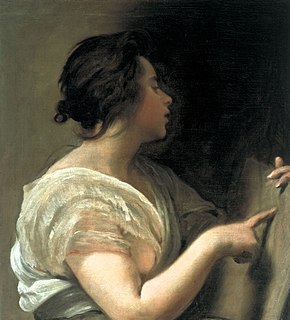
Figure skating is a sport in which individuals, duos, or groups perform on figure skates on ice. It was the first winter sport included in the Olympics, in 1908. The four Olympic disciplines are men's singles, ladies' singles, pair skating, and ice dance. Non-Olympic disciplines include synchronized skating, Theater on Ice, and four skating. From juvenile through senior-level competition, skaters generally perform two programs which, depending on the discipline, may include spins, jumps, moves in the field, lifts, throw jumps, death spirals, and other elements or moves.

Helvetia is the female national personification of Switzerland, officially Confœderatio Helvetica, the Swiss Confederation.
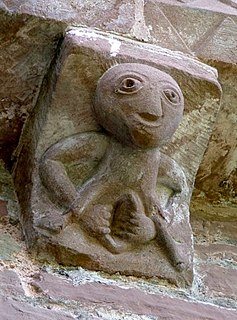
Sheela na gigs are figurative carvings of naked women displaying an exaggerated vulva. They are architectural grotesques found all over Europe on cathedrals, castles, and other buildings. The highest concentrations can be found in Ireland, Great Britain, France and Spain, sometimes together with male figures. Ireland has the greatest number of surviving sheela na gig carvings; Joanne McMahon and Jack Roberts cite 101 examples in Ireland and 45 examples in Britain. One of the best examples may be found in the Round Tower at Rattoo, in County Kerry, Ireland. There is a replica of the Round Tower sheela na gig in the County Museum in Tralee town. Another well-known example may be seen at Kilpeck in Herefordshire, England.
A gender symbol is a pictogram or glyph used to represent
either biological sex or sociological gender in either biology, medicine, genealogy or selective breeding, or in sociology, gender politics, LGBT subculture and identity politics.

The internal pudendal artery is one of the three pudendal arteries that branches off the internal iliac artery, providing blood to the external genitalia.

A figure drawing is a drawing of the human form in any of its various shapes and postures using any of the drawing media. The term can also refer to the act of producing such a drawing. The degree of representation may range from highly detailed, anatomically correct renderings to loose and expressive sketches. A "life drawing" is a drawing of the human figure from observation of a live model. A figure drawing may be a composed work of art or a figure study done in preparation for a more finished work such as a painting. Figure drawing is arguably the most difficult subject an artist commonly encounters, and entire courses are dedicated to the subject. The human figure is one of the most enduring themes in the visual arts, and the human figure can be the basis of portraiture, illustration, sculpture, medical illustration, and other fields.
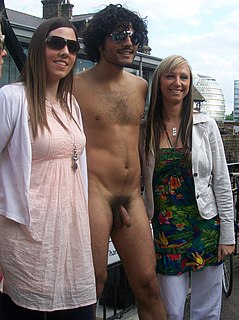
Clothed female, naked male (CFNM) is a genre of erotica based on the real or imagined interaction of one or more nude men and one or more clothed women. It is sometimes a sexual fantasy of women or men, depicting an exhibitionist or physique worship scenario. CFNM situations can arise in situations where a male disrobes as part of a male striptease, a medical examination, as a figure model for art students, or is forced to remove clothing as a punitive measure. In pornography or erotic writing, CFNM depicts a power exchange where the more traditionally dominant male is objectified, debased, or humiliated by a more traditionally submissive female. As a result, CFNM fiction frequently includes the clothed female taking on the role of a dominatrix over the nude male.
Ria Baran was a German pair skater. She skated together with Paul Falk and twice became World champion and in 1952 Olympic champion. She was one of the oldest female figure skating Olympic champions.
Fitness and figure competition is a class of physique-exhibition events for women. While bearing a close resemblance to female bodybuilding, its emphasis is on muscle definition, not size. The class was originally introduced when female bodybuilding's popularity began to noticeably decline, in terms of both fanbase and number of participants.
In recent years organizations like NPC have done away with the female bodybuilding division altogether, only Physique, Figure, Fitness and Bikini divisions remain.

Hadrian and Sabina as Mars and Venus is a 1.73m tall marble statue of 120-140 AD.

The nude figure is a tradition in Western art, and has been used to express ideals of male and female beauty and other human qualities. It was a central preoccupation of Ancient Greek art, and after a semi-dormant period in the Middle Ages returned to a central position in Western art with the Renaissance. Athletes, dancers, and warriors are depicted to express human energy and life, and nudes in various poses may express basic or complex emotions such as pathos. In one sense, a nude is a work of fine art that has as its primary subject the unclothed human body, forming a subject genre of art, in the same way as landscapes and still life. Unclothed figures often also play a part in other types of art, such as history painting, including allegorical and religious art, portraiture, or the decorative arts.
Female body shape or female figure is the cumulative product of her skeletal structure and the quantity and distribution of muscle and fat on the body.
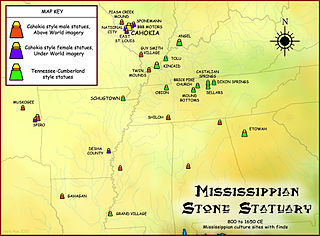
The Mississippian stone statuary are artifacts of polished stone in the shape of human figurines made by members of the Mississippian culture and found in archaeological sites in the American Midwest and Southeast. Two distinct styles exist; the first is a style of carved flint clay found over a wide geographical area but believed to be from the American Bottom area and manufactured at the Cahokia site specifically; the second is a variety of carved and polished locally available stone primarily found in the Tennessee-Cumberland region and northern Georgia. Early European explorers reported seeing stone and wooden statues in native temples, but the first documented modern discovery was made in 1790 in Kentucky, and given as a gift to Thomas Jefferson.
The Axel is a figure skating jump with a forward take off. It is named after Norwegian figure skater Axel Paulsen who, in 1882, was the first skater to perform the jump. Compared to other common figure skating jumps, an Axel has an extra ½ rotation in the air because of its forward take off. Most skaters perform the jump with counterclockwise rotation, taking off from the left forward outside edge and landing on the right back outside edge. The Axel can also be done as a double jump with 2½ rotations, or as a triple jump with 3½ rotations, or a quadruple Axel with 4½ rotations, but no skater has yet accomplished a quadruple Axel in competition.

Acqua Grylli is a public art work by American artist Beth Sahagian, located on the Riverwalk in downtown Milwaukee, Wisconsin. The artwork is a bronze arch depicting a mythical female figure. It is located on the west side of the Milwaukee River between Wells Street and Kilbourn Avenue.
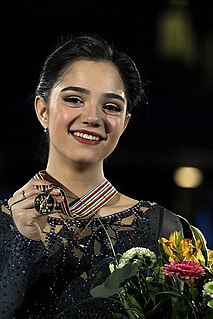
Evgenia Armanovna Medvedeva, is a Russian figure skater. She is a two-time Olympic silver medalist, a two-time world champion, a two-time European champion, a two-time Grand Prix Final champion, two-time Russian national champion.

Hungary competed at the 2018 Winter Olympics in PyeongChang, South Korea, from 9 to 25 February 2018. With the men's 5000 metre relay victory in short track speed skating, the nation had won its first ever Winter Olympic gold, and first Winter medal since 1980. Hungarian athletes have participated in all Winter Olympic Games.

Mixed-sex sports, also known as mixed-gender or coed sports, are sports where the participants are not of a single sex. This can take the form of individual or team sports involving people of different sexes. In organised sports settings, rules usually dictate the number of people required of each sex in a team. Such rules account for the sex differences in human physiology, with males being larger and stronger than females on average. In informal settings, mixed-sex sports typically involves groups of friends and/or family engaging in sport without regard to the sex of the participants.

